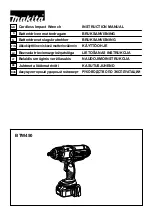
3 of 6
ASSEMBLY AND OPERATING INSTRUCTIONS
To attach a quick connector
WARNING
Prior to performing any assembly and/or adjustment procedures,
make sure the air supply hose (not included) is disconnected from the impact
wrench.
1.Prior to use, the impact wrench requires the attachment of a quick-connector into its air
inlet. To do so, wrap approximately 3in. of pipe thread sealer tape (not included) around
the male threads of a quick-connector. Then, firmly tighten the quick-connector into the
air inlet.
SPEED SELECTOR
Four speeds can be selected. To change speed push in and rotate the selector dial at the
base of the handle. Do not change speeds whilst tool is in motion.
LOOSENING
1.Attach the correct size socket to the anvil.
2.Set the compressor's pressure regulator to 90 PSI. Do not set the compressor's outlet
regulator above 90PSI.
3.Connect the tool to the air compressor's hose. If leakage is detected, disconnect the air
hose and fix it correct before use.
4.Place the socket over the nut to loosen.
5.Grip the tool firmly. Press the REVERSE valve in from the area above the trigger so that
the REVERSE valve protrudes out the back of the housing. Press the trigger to start the
tool.
(Caution: Make sure the nut or bolt can withstand the impact wrench's working
torque.)
NOTE:
Ø
If the tool cannot loosen the nut, DO NOT raise the outlet pressure of the air
compressor.
Ø
When the nut is moved, stop the tool by releasing the trigger and remove the tool
from the nut. Remove the nut from the socket if needed.
Tightening
The working torque of the impact wrench is 230 ft.-lbs. Make sure that the nut or bolt you
are using the tool to tighten can withstand the rated torque.
1.Tighten the nut as far as you can by hand.
2.Place the socket on the nut. Press the REVERSE valve forward so it protrudes out the
front of the Housing. Press the trigger to start the tool.
NOTE:
Ø
If the tool stalls while tightening, DO NOT raise the outlet pressure of the air compressor
above 90 PSI.
Ø
When the nut has been tightened, remove the tool and socket. Do not over-tighten.
Ø
If available, check the recommended torque specifications for the nut. You should use a
torque wrench to torque the nut after using the impact wrench.
Fig. 1
2 of 6
4.Remove adjusting keys or wrenches before turning on the tool. A wrench or a key that is
left attached to a rotating part of the tool may result in personal injury.
5.Do not overreach. Keep proper footing and balance at all times. Proper footing and
balance enables better control of the tool in unexpected situations.
6.Use safety equipment. Always wear ANSI-approved safety glasses underneath a full
face shield, and hearing protection.
USE AND CARE
1.Use clamps or other practical ways to secure and support the workpiece to a stable
platform. Holding the work by hand is unstable and may lead to loss of control. Only work
on a workpiece that is properly secured.
2.Do not force or modify the tool. Use the correct tool for your application. The correct tool
will do the job better and safer at the rate for which it is designed.
3.Do not use the power tool if the trigger does not turn it on or off. Any tool that cannot be
controlled with the Trigger is dangerous and must be replaced.
4.Disconnect the air hose from the tool before making any adjustments, changing
accessories, or storing the tool. Such preventive safety measures reduce the risk of
starting the tool accidentally.
5.Store idle tools out of reach of children and other untrained persons. Tools are
dangerous in the hands of untrained users.
6.Maintain tools with care. Do not use a damaged tool. Tag damaged tools "Do not use"
until repaired.
7.Check for misalignment or binding of moving parts, breakages of parts, damaged air
hose (not included), and any other condition that may affect the tool's operation. If
damaged, have the tool serviced before using. Many accidents are caused by poorly
maintained tools.
8.Use only accessories that are recommended by the manufacturer for your model.
Accessories that may be suitable for one tool may become hazardous when used on
another tool.
SERVICE
1.Tool service must be performed only by qualified repair personnel. Service or
maintenance performed by unqualified personnel could result in a risk of injury.
2.When servicing a tool, use only identical replacement parts. Follow instructions in the
Inspection, Maintenance and Cleaning
section of this manual. Use of unauthorized
parts or failure to follow maintenance instructions may create a risk of injury.
SPECIFIC SAFETY RULES
1.To avoid accidental injury, always wear ANSI-approved safety glasses, a full face shield,
and hearing protection when operating the tool.
2.Use clean, dry, regulated, compressed air at 90 PSI. Do not exceed the recommended
90 PSI. Never use oxygen, carbon dioxide, combustible gases, or any other bottled gas
as a power source for this tool.
3.When connecting to the air supply: Prior to each use, if an automatic oiler is not used,
add two drops of air tool oil (not included) into the air inlet fitting of the tool.
4.Always disconnect the tool from its compressed air supply source, and squeeze the
trigger to release all compressed air in the tool before performing any maintenance or
service.
5.The warnings, precautions, and instructions discussed in this manual cannot cover all
possible conditions and situations that may occur. The operator must understand that
common sense and caution are factors which cannot be built into this product, but must
be supplied by the operator.






















